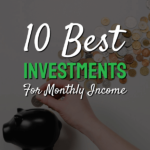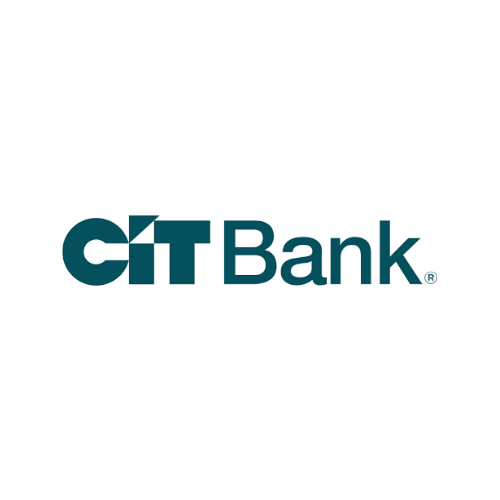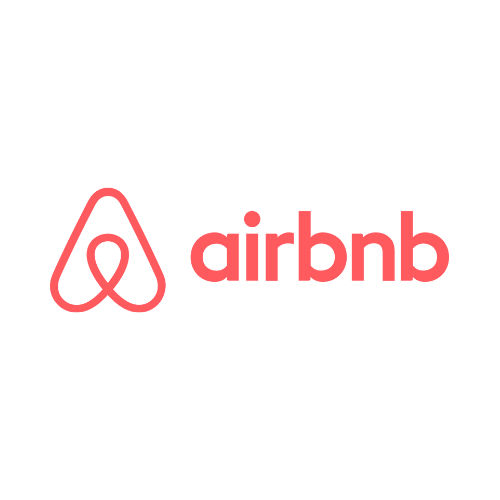Being able to afford retirement is a financial goal many people want to achieve. Some people reach this goal by saving enough money to no longer rely on working full-time to make ends meet.
There is another option to help you reach your retirement goals. You can focus on investments to earn monthly income that can eventually replace your paycheck.
While the following investments have different risk levels and give you exposure to other asset classes, their one common trait is that they can help you earn a monthly income.
Top Investments for Monthly Income
These investing ideas can help you earn recurring income. Some options are riskier than others, and each one has a different income potential.
As always, it’s important to diversify your portfolio and invest in assets that fit your risk tolerance.
1. Dividend Stocks
Target annual yield: 1.5% to 5%
Stocks can make investors money in two ways. The first and most commonly known method is appreciating share prices. The second is dividend income.
Dividend income is when a company you own stock in has extra profits and, as a result, you receive a cash payment.
There are several ways to earn dividend income, including:
- Dividend-focused index funds
- Individual stocks
- Real estate investment trusts (REITs)
Many index funds pay at least one dividend payment per year. The average dividend yield for the S&P 500 is currently 1.48%.
Not every stock pays a dividend, but many well-established “blue-chip stocks” pay quarterly dividends. Investors may buy individual dividend stocks to earn dividend income each month.
You can reinvest your dividends to buy additional shares of the same stock with a dividend reinvestment plan. A second option is to live off the dividends if your portfolio is large enough.
Dividend income is excellent, but you can still lose money if the share price drops more than the dividend yield.
Also, a company may suspend or reduce the dividend payment if they have financial challenges. This can spark a stock selloff as dividend investors switch to higher-paying dividend stocks.
Tracking your dividend income and net worth can be difficult as your portfolio expands. You can use The Dividend Tracker to monitor your net worth and investments for free.
Creating a Monthly Dividend Portfolio
Each company pays dividends in different months. As a result, you will need to hold several stocks to earn at least one dividend payment each month.
One model portfolio could include these three stocks:
- Nike (NKE): January, April, July and October
- Starbucks (SBUX): February, May, August and November
- Visa (V): March, June, September and December
You’ll receive a dividend payment each month of the year with this portfolio. That said, this isn’t the only portfolio you could create. There are many other options depending on the stocks you want to buy.
As always, perform your due diligence and research stocks before investing.
Pros
- Earn passive income without selling stocks
- Dividend stocks can be less risky than growth stocks
- Can also make money when share prices rise
Cons
- Stock prices may decline more than dividend yield
- Dividend payments could be reduced or halted due to financial troubles
2. Certificate of Deposits
Target annual yield: 1.9%
Bank certificates of deposits (CDs) can earn more than high-yield savings accounts since you invest your cash for a specific number of months. An early redemption means you forfeit several months of interest income.
Most CDs let you either receive monthly interest payments or get the full amount at the end of the investment term.
As interest rates can fluctuate, building a CD ladder lets you capture the best current rates. Your ladder can have staggered maturity dates so you can diversify your interest yields.
CDs can be a low-risk investment and are FDIC-insured. However, you should only invest cash you don’t need instant access to during the CD term.
Banks do offer no-penalty CDs. These don’t have an early redemption penalty, but they do have a lower yield than term CDs.
The minimum investment varies by bank. Several banks have a $0 minimum, but others may require at least $500 or more.
Banks also offer CD IRAs. These accounts can reduce your taxable interest income, but you won’t be able to access your cash until you reach retirement age.
Pros
- May earn a higher yield than a savings account
- Can withdraw interest before CD matures
- FDIC-insured
Cons
- Early redemption penalties apply
- Most CD terms are at least 12 months
3. High-Yield Savings Accounts
Target annual yield: 0.70%
A high-yield savings account can earn a higher interest rate than a traditional savings account. You can also make penalty-free withdrawals.
Most high-yield accounts don’t require a minimum initial deposit or an ongoing balance. Also, the accounts don’t charge a monthly service fee like a typical brick-and-mortar bank.
There are some caveats that regular savings accounts don’t have. For example, the account might be online-only and only permit up to six monthly withdrawals.
Despite these limitations, high-interest bank accounts are one of the best short-term investments to store your cash.
Pros
- Higher interest rate than a traditional savings account
- No minimum balance requirements
- FDIC-insured
Cons
- Up to six monthly withdrawals (it’s federal law)
- May earn less than the annual inflation rate
4. Bond Index Funds
Target annual yield: 0.10% to 3.30%
Investment-grade corporate and government bonds are a staple fixed-income investment. Bonds have lower growth potential than stocks, but they are more likely to earn recurring income.
Index funds that you buy in your 401k or with an investing app can be the easiest way to invest in bonds.
Most bond index funds are for investment-grade corporations and government bonds. These are widely traded and can be less risky than “junk bonds” or foreign bonds that have lower credit ratings but higher potential yields.
One example of a bond index fund is the Vanguard Total Bond Market ETF (BND). This fund lets investors get exposure to U.S. Treasury bonds and investment-grade U.S. corporate bonds.
If you want to invest outside of the United States, some funds invest in international bonds.
Other funds focus on holding bonds with different maturity dates, such as 10 years or 20 years. Longer-term bonds typically have higher yields than short-term bonds.
Bond index funds can be an important part of a Boglehead three-fund portfolio. One downside of bond funds is that the share price and yield rate can fluctuate.
Investors with lots of disposable cash can buy individual bonds. These bonds may have a minimum investment of $50,000 per position but can have higher yields than a bond index fund.
As interest rates are near historic lows, bond yields are lower than previous averages. Investors may prefer dividend stocks with more growth potential despite the extra volatility.
Regardless, it’s a good idea to hold some bonds to minimize portfolio volatility during a stock market correction. A robo-advisor can recommend an age-based asset allocation of stock and bond index funds.
Pros
- Can be less volatile than dividend stocks
- Invest in corporate and government bonds
Cons
- Less growth potential than high-quality dividend stocks
- “Junk bonds” might be too risky despite higher yields
5. Small Business Bonds

Target annual yield: 5%
Small business bonds are too small for bond funds to invest in, but they can earn a steady income for individual investors.
Worthy Bonds offers small business bonds with a $10 minimum investment and a 5% annual yield. Notes mature after 36 months, but you can sell your shares early with no early redemption penalty.
Since these bonds are riskier than corporate and government bonds, they pay a higher annual yield. Small businesses borrow at a higher rate, and you earn 5% of the interest income.
You may consider these bonds instead of non-investment-grade “junk bonds” that can have competitive yields.
While small business bonds are collateral-backed, it’s possible to lose your investment balance if the borrower defaults.
Pros
- Higher annual yields than corporate and government bonds
- Can help small businesses grow
Cons
- Riskier than investment-grade corporate bonds
- Cannot buy through an online broker or employer retirement plan
Read our Worthy Bonds review to learn more about small business bonds.
6. Crowdfunded Real Estate
Target annual return: 6% to 12%
Crowdfunded real estate lets you earn passive income from multifamily apartments and commercial real estate. You invest in public, non-traded projects that require a multi-year investment commitment.
This real estate investing idea can earn higher returns than a REIT or real estate index fund that you can buy with an investing app.
Crowdfund real estate also doesn’t have variable share prices like REITs trading on the stock market. Better yet, you don’t have to self-manage the property as if you own rental real estate.
Most platforms have a minimum five-year investment period. On top of that, it can take several months to sell your shares since real estate is an illiquid asset.
The investment minimum is determined by the platform and could be at least $1,000 or higher. Certain platforms are only available to accredited investors with a high net worth.
Your potential annual returns depend on whether the investment has a debt or equity debt structure. Depending on the structure, investors can expect annual returns between 6% and 12%.
Debt Real Estate
Debt-structured deals are more likely to earn monthly income and are less risky. Most debt REITs annual returns are between 6% and 8% and pay quarterly dividends.
Investors make money by collecting interest payments from borrowers and monthly rental income.
Fundrise lets accredited and non-accredited investors get access to crowdfund real estate with a $1,000 minimum investment. You can reinvest your dividends or receive a quarterly cash distribution.
The minimum investment period is five years to avoid an early redemption penalty.
Equity Real Estate
Equity deals have higher growth potential and earn most of the investment at the end of the investment term. The fund management team sells properties at a higher value, making the average annual return as high as 12%.
Investors may also earn a small dividend from interest payments or monthly rental income until the property sells.
Pros
- Earn dividend income from multifamily and commercial real estate
- Can be less volatile than public REITs
- You don’t have to manage properties
Cons
- Multi-year investment commitment
- Some platforms only accept accredited investors
- Cannot sell shares quickly like public REITs
7. Single-Family Rental Property
Target annual return: 4% and 10%
Buying rental property can be another way to earn passive income by collecting monthly rent. Crowdfunding platforms usually won’t invest in single-family rental homes because there are fewer tenants per property.
That said, owning a rental property can be better than crowdfund real estate since you can invest locally or out-of-state. You can also earn more income and have more flexibility as you own the entire property.
Keep in mind that you will need to screen tenants and handle property maintenance unless you hire a property manager.
It’s possible to find local rental properties by hiring a real estate agent. If your local market isn’t profitable, another option is using Roofstock. This site lists properties for sale across the United States.
It’s important to find properties where the potential income is higher than the annual property taxes and possible maintenance costs.
Real estate investors call your net profit your “cap rate.” Most cap rates are between 4% and 10%, which is your annual investment return after all expenses.
Pros
- Can own local rental properties
- Higher income potential than REITs
- Collect monthly rental income
Cons
- Responsible for property management
- Expenses can exceed monthly income
- Vacancies and missed rental payments can impact income
Discover other ways to invest in real estate and make recurring income.
8. Be an Airbnb Host

Target annual return: 8% to 12%
Having long-term tenants as a landlord isn’t an exciting option for all investors. You might be able to make more money or avoid stress by being an Airbnb host.
Vacation rental homes are becoming more popular than hotels because of the extra privacy. You can make extra money by renting a spare room or a second house.
Entering your property details on the Airbnb website lets you estimate your monthly income. For example, Airbnb estimates an entire house can earn up to $2,000 per month in Orlando, Florida.
Unlike owning a long-term rental, you can designate which days you’re available to accept guests. This scheduling flexibility could be worth it if you can earn more renting to vacationers than tenants.
If you don’t want to clean up between guests, you will need to hire a property manager and cleaning service. Travel slowdowns and local laws restricting short-term rentals are potential risks that may impact your income.
Pros
- Can earn more than long-term rentals in certain cities
- Flexible schedules
- Can rent a spare room or a separate property
Cons
- Responsible for property maintenance and cleaning
- Poor reviews from guests can reduce future bookings
Learn more about becoming an Airbnb host.
9. Peer-to-Peer Investing
Target annual return: 3% to 8%
Lending money directly to others with peer-to-peer lending lets you earn monthly passive income.
You can buy notes for a three-year or five-year personal loan. The borrower makes monthly interest payments.
Prosper lets you buy $25 notes in peer loans. The historical average annual return is 5.4% after fees and defaults, according to the platform.
Investors can invest in loans with higher or lower risk ratings. Higher risk ratings have higher potential yields.
You lose the remaining investment balance if the borrower defaults on their loan. All peer-to-peer loans are unsecured and not backed by collateral.
Pros
- Higher potential returns than bank accounts or bonds
- Low investment minimums
Cons
- Three or five-year investment commitment
- Lose remaining investment amount if the borrower defaults
10. Royalties
Target annual yield: 5% to 20%
Owning royalty rights is another unique way to earn recurring income.
It’s possible to buy the publishing rights to new and old music and movies. You can self-publish your content or purchase the rights from another artist or royalty holder.
Some of the royalties you can buy include:
- Songs or music albums
- Movies and TV shows
- Books
- Educational material
- Trademarks
Royalty Exchange has auction listings for royalty deals. You can earn royalty income each time someone uses your product or service.
Anyone can invest in royalties, but auctions can be expensive. Auctions may require you to invest $100,000 or more to buy the copyright to well-known songs and movies.
Before placing a bid, compare the recent royalty income to the potential purchase price. You will need to determine how long you’re willing to wait to pay off the original investment and earn a profit.
An enormous risk is that the royalty income decreases sharply. One example is if a streaming app no longer offers a certain song or movie in its catalog.
Pros
- Own copyright to songs, movies or published material
- Royalty income increases with more use
- Multi-year investment idea
Cons
- Premium plan can be expensive
- Basic charting tools
How Investments That Pay Monthly Compare
Check out how much monthly income you would potentially receive if you invested $100,000 in each of the investments below.
| Investment | Max % | Monthly Amount |
| Dividends | 5.0% | $416.67 |
| Certificate of Deposit | 1.9% | $158.33 |
| Savings Account | 0.7% | $58.33 |
| Bond Index Fund | 3.3% | $275 |
| Small Business Bonds | 5.0% | $416.67 |
| Crowdfunded Real Estate | 12% | $1,000.00 |
| Rental Property | 10% | $833.33 |
| Airbnb | 12% | $1,000.00 |
| Peer-to-peer | 8.0% | $666.67 |
| Royalties | 20% | $1666.67 |
FAQs
Before you start investing to earn monthly income, it’s important to understand the potential risks and rewards. These frequently asked questions can help.
The best way to earn a monthly income is different for each investor. You will need to determine your risk tolerance, investment goals and budget.
Bonds, dividend stocks and high-yield cash accounts are the most popular options because of the small investment minimums and relatively low risk.
However, real estate can be a better option for investors with a multi-year investment horizon and a higher cash balance. Real estate can also be less volatile than stocks and bonds that have fluctuating share price values.
Yes, it is possible to earn monthly passive income by investing in stocks,
bonds, etc.
Some investments naturally pay monthly dividend income. Others may pay on a quarterly or annual basis.
Investors might need to invest in multiple assets that have scheduled distributions in different months. It can be possible to earn monthly payments when at least one asset pays interest each calendar month.
Some months may have higher payouts than others since payouts will differ between investments.
All investments have some risk, but high-yield savings accounts or money market accounts can be the least risky.
These interest-bearing bank accounts usually have FDIC insurance up to $250,000 per account. Similar credit union accounts offer up to $250,000 in NCUA coverage.
However, safety comes at a price. Interest-bearing bank accounts have some of the lowest interest rates, which means your monthly income won’t be as high.
Some of the riskiest income-producing assets can include stocks, small business bonds and even peer-to-peer loans.
Peer-to-peer loans can be the riskiest because you lend money to an individual borrower with an unsecured personal loan. The lender can’t collect collateral to offset the remaining loan balance.
Small business bonds can be riskier than corporate or government bonds since small businesses tend to have fewer cash reserves and lower credit ratings.
Dividend stocks can vary in risk. Blue-chip stocks that are well-known and have large cash reserves can be less risky than a growing technology company that pays a smaller dividend.
However, a stock market correction can cause share prices to decline more than the dividend yield. This event can spark a negative annual return.
Buying a dividend-focused index fund can be less risky than holding individual stocks because your cash is more diversified.
Summary
Investing to earn monthly income can be relatively easy. Depending on the investment, it may only require a small amount of cash to get started.
Don’t forget to do your research before investing. While no investment is risk-free, investing in several ideas gives you multiple ways to earn dividends and reduce risk.









